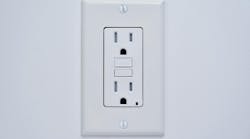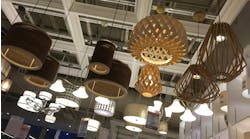Courtesy of www.MikeHolt.com.
All questions and answers are based on the 2023 NEC.
Q1: In other than dwelling units, all 125V through 250V receptacles supplied by single-phase branch circuits rated 150V or less to ground, 50A or less, and all receptacles supplied by three-phase branch circuits rated 150V or less to ground, 100A or less, installed in _____, shall be provided with GFCI protection.
a) laundry areas
b) finished basements
c) attics
d) guest rooms and suites
Q2: The total degrees of bends in a run of FMC _____ between pull points.
a) shall not be made
b) need not be limited (in degrees)
c) shall not exceed 360 degrees
d) shall not exceed 180 degrees
Q3: Metal enclosures and raceways containing _____ conductors shall be connected to the grounded system conductor if the electrical system is grounded.
a) feeder
b) service
c) branch-circuit
d) outside feeder or branch-circuit
Q4: The ampacity of UF cable shall be that of _____ conductors in accordance with Sec. 310.14.
a) 60°C
b) 75°C
c) 90°C
d) 105°C
Q5: A connection used for no other purpose shall be made between the metal box and the equipment grounding conductor(s). The equipment bonding jumper or equipment grounding conductor shall be sized from Table 250.122 based on the largest _____ conductors in the box.
a) overcurrent device protecting circuit
b) ungrounded
c) grounded
d) neutral
Q6: Where PVC, RTRC, or HDPE is used in Class I, Division 1 underground locations, the concrete encasement shall be permitted to be omitted where RMC or IMC conduit is used for the last _____ of the underground run to emergence or to the point of connection to the aboveground raceway.
a) 12 in.
b) 18 in.
c) 24 in.
d) 30 in.
Answers:
Q1: a) laundry areas.
Section 210.8(B)(14) lists "laundry areas" as a location that shall be provided with GFCI protection.
Q2: c) shall not exceed 360 degrees
As stated in Sec. 348.24(B), "The total degrees of bends in a conduit run shall not exceed 360 degrees between pull points."
Q3: b) service
According to Sec. 250.80, "Metal enclosures and raceways for service conductors and equipment shall be connected to the grounded conductor if the electrical system is grounded."
Q4: a) 60°C
Per Sec. 340.80: "The ampacity of Type UF cable shall be that of 60°C conductors in accordance with 310.14."
Q5: a) overcurrent device protecting circuit
Section 250.148(C) states, "A connection used for no other purpose shall be made between the metal box and the equipment grounding conductor(s). The equipment bonding jumper or equipment grounding conductor shall be sized from Table 250.122 based on the largest overcurrent device protecting circuit conductors in the box."
Q6: c) 24 in.
Per Sec. 501.10(A)(1)(2), "RMC or IMC conduit shall be used for the last 24 in. of the underground run to emergence or to the point of connection to the above ground raceway."
These materials are provided by Mike Holt Enterprises in Leesburg, Fla. To view Code training materials offered by this company, visit www.mikeholt.com/code.





